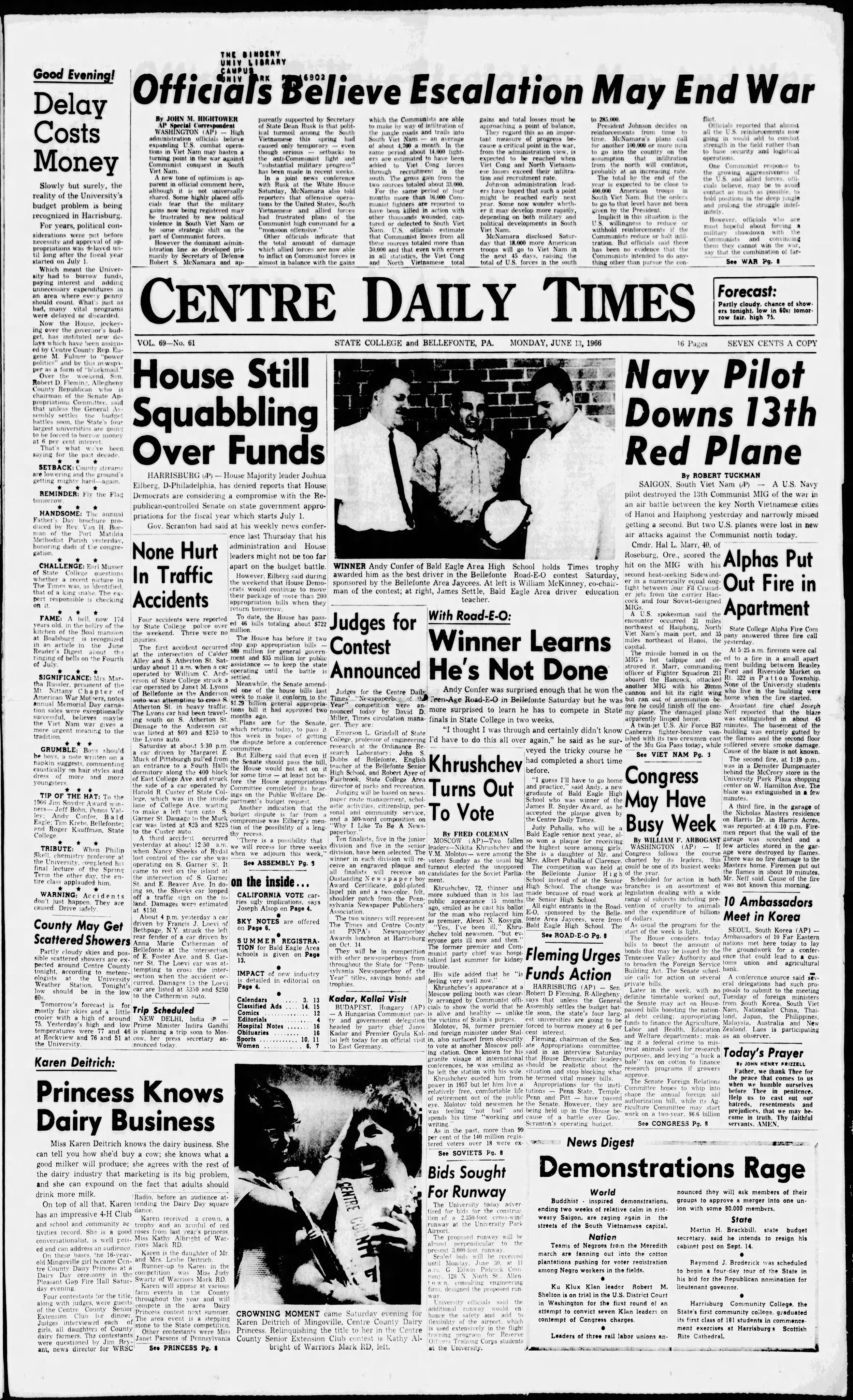The Vietnam War, This Week, The Centre Daily Times, State College PA
Vietnam War Weekly Front Pages
12 June 1966 – 18 June 1966
The Centre Daily Times, State College PA
Self-immolation as a form of protest.
*****
High administration officials believed expanding US combat operations in Vietnam may hasten a turning point in the war against Communist conquest in South Vietnam. A new tone of optimism was apparent in official comment, although it was not universally shared. Some highly placed officials feared that the military gains now being registered may be frustrated by new political violence in South Vietnam or by some strategic shift on the part of Communist forces. However, the dominant administration line as developed primarily by Secretary of Defense Robert S McNamara and apparently supported by Secretary of State Dean Rusk was that the political turmoil among the South Vietnamese in the spring had caused only temporary – even though serious – setbacks to the anti-Communist fight and “substantial military progress” had been made in recent weeks. The total by the end of 1966 was expected to be close to 400,000 American troops in South Vietnam. But the orders to go to that level had not been given by the president.
In Saigon, government security forces, with orders to give no quarter, laid virtual siege to the Buddhist Institute. With pistol shots and teargas charges they choked off dozens of demonstrations after a mob burned three American Jeeps and grabbed two submachine guns from American military police. Told to arrest draft-age demonstrators on the spot and send them off to military service, troops and riot police carted away scores. Some were clubbed, kicked, and beaten. 400 miles to the north the chief of Premier Nguyen Cao Ky’s Buddhist antagonists, Thich Tri Quang, was in the seventh day of an anti-American, anti-government hunger strike. An aide said his condition was “weakening and very serious.” Late in the week, Premier Ky pushed his radical Buddhist opponents further into a corner by sending his paratroopers into Hué and slapping a 9 PM nightly curfew on Saigon. The paratroopers opened fire on dissident Vietnamese soldiers who tried to stage a march with Buddhist banners in the northern city. Marchers fled after a heavy burst of fire, and some blood remained on the streets after the altercation. In return, radical Buddhists called for three-day general strike, but the moderate head of the Buddhist Institute, Thich Tam Chau, warned that their chaotic, emotional struggle against the military regime may bring the collapse of the church. As violence continued in Saigon for the fifth consecutive day, he issued his appeal from a secret hideaway after he abandoned the beleaguered Buddhist Institute compound to more militant monks. Police officials reported that the 16-year-old Buddhist girl who had set herself afire in an anti-government protest Friday night had died. Her death brought to 10 the number of self-immolations since 29 May.
On the military front, chief interest remained centered on the battle of American and South Vietnamese troops against North Vietnamese regulars on the Kontum plateau of the central highlands. A US spokesman said 465 of the enemy were known dead. The US tolls were reported to be less than a 10th that. On Saturday, American B-52 bombers rounded out one year of raids against Communist targets in Vietnam and marked the anniversary with two big attacks against the Communist guerrillas. One wave of the Guam-based B-52’s hit a Viet Cong troop concentration 35 miles southwest of Da Nang. Another formation of the eight-engined bombers hammered two Viet Cong base camps 75 miles northwest of Saigon. The target area was in War Zone C near the Cambodian border, long a Communist troop stronghold. Ground fighting dwindled to only minor Allied contact with the Viet Cong.
The flimsy screen that covered the Laotian scene, giving it an apparent internal political and military stability, had cracked recently. Although on a far smaller scale, there was some similarity with events in neighboring South Vietnam. Both countries were threatened by Communist aggression, but Laotian generals seemed to concentrate more on strengthening their own personal interests than on containing the Communist Pathet Lao. The United States was deeply committed and faced the dilemma of perpetual quarrels among generals whom it supported.
(Photo courtesy newspapers.com, State College Centre Daily Times)

